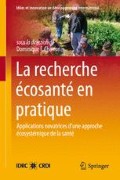Abstract
Dans la ville de Bebnine (environ 16 000 habitants), au nord du Liban, une équipe de chercheurs de l’Université américaine de Beyrouth et des résidents de la localité ont travaillé ensemble à un projet de recherche communautaire fondé sur une approche écosystémique afin de mieux comprendre les relations entre la population, l’eau et la santé (Forget et Lebel 2001; Lebel 2003). Au départ, l’étude s’est penchée en particulier sur les répercussions de l’utilisation d’eau d’irrigation polluée et de produits agrochimiques sur la qualité des produits maraîchers locaux. Toutefois, des réunions préliminaires avec les principaux intervenants de la collectivité ont mis en lumière les inquiétudes de la population au sujet de l’incidence apparemment élevée de maladies gastro-intestinales chez les habitants de cette ville. Ce problème plus urgent a entraîné la modification de la portée du projet afin qu’il corresponde davantage aux priorités communautaires et soit axé sur les liens entre la qualité de l’eau potable et la santé et le bien-être de la collectivité. Les résultats de ces travaux ont orienté l’élaboration et la mise en œuvre d’interventions communautaires à court et à moyen terme pour atténuer les effets des problèmes de santé liés à l’eau.
Au nom de l’équipe de recherche de Bebnine.
Access this chapter
Tax calculation will be finalised at checkout
Purchases are for personal use only
Bibliographie
Abou Mourad, T.A. (2004). « Palestinian Refugee Conditions Associated with Intestinal Parasites and Diarrhea: Nuseirat Refugee Camp as a Case Study », Public Health, vol. 118, p. 131–142.
Al-Ghazawi, Z. (2004). « Ecosystem Approach to Human Health in Two Villages of the North Jordan Valley: Scoping the Problems », EcoHealth, vol. 1, suppl. 2, p. 97–108.
Al-Medhwahi, E., Briggs, C., et Keane, S. (2005). Household Hygiene Improvement Survey in Yemen: Knowledge, Practices, and Coverage of Water Supply, Sanitation and Hygiene. US Agency for International Development (USAID), Washington, DC, É.-U.
El Azar, G., Habib, R.R., Mahfoud, Z., El-Fadel, M., Zurayk, R., Jurdi, M., et Nuwayhid, I. (2009). « Effect of Women’s Perceptions and Household Practices on Children’s Waterborne Illness in a Low Income Community », EcoHealth, vol. 6, no 2, p. 169–179.
Forget, G., et Lebel, J. (2001). « An Ecosystem Approach to Human Health », International Journal of Occupational and Environmental Health, vol. 17, p. S3–S35.
Fewtrell, L., Kaufmann, R.B., Kay, D., Enanoria, W., Haller, N., et Colford, J.M. (2005). « Water, Sanitation, and Hygiene Interventions to Reduce Diarrhea in Less Developed Countries: A Systematic Review and Meta-Analysis », The Lancet Infectious Diseases, vol. 5, p. 42–52.
Lebel, J. (2003). La santé : une approche écosystémique. Centre de recherches pour le développement international, Ottawa, Canada. http://www.idrc.ca/FR/Resources/Publications/Pages/IDRCBookDetails.aspx?PublicationID=332.
OMS (Organisation mondiale de la Santé) (2006). Guidelines for Drinking-Water Quality. First Addendum to Third Edition. Volume 1, Recommendations. OMS, Genève, Suisse. http://www.who.int/water_sanitation_health/dwq/gdwq0506.pdf.
US-EPA (United States Environmental Protection Agency) (2010). Drinking Water Contaminants. US-EPA, Washington, DC, É.-U. http://www.epa.gov/safewater/contaminants/index.html.
Wright, J., Gundry, S., et Conroy, R.M. (2004). « Household Drinking Water in Developing Countries: A Systematic Review of Microbiological Contamination Between Source and Point-Of-Use », Tropical Medicine and International Health, vol. 9, p. 106–117.
Remerciements
Je tiens à remercier mes collègues de l’équipe de recherche de l’Université américaine de Beyrouth, Iman Nuwayhid, Mutasem El-Fadel, Rami Zurayk, Dima Jamali, Mona Haidar, Hind Farah, Grace El Azar et Safa Hojeij, ainsi que les membres du Comité consultatif du projet. Merci également à la population de Bebnine, au maire et au conseil municipal élu, aux directeurs d’école, aux associations de femmes et aux directeurs de centres de santé pour leur précieuse collaboration. Le CRDI a accordé son soutien à ces travaux dans le cadre du projet n° 101815.
Author information
Authors and Affiliations
Corresponding author
Editor information
Editors and Affiliations
Rights and permissions
Copyright information
© 2014 Centre de recherches pour le développement international
About this chapter
Cite this chapter
Habib, R.R. (2014). Comprendre l’eau pour comprendre la santé – le cas de Bebnine, au Liban. In: Charron, D. (eds) La Recherche Écosanté en pratique. Insight and Innovation in International Development, vol 2. Springer, New York, NY. https://doi.org/10.1007/978-1-4614-5281-2_19
Download citation
DOI: https://doi.org/10.1007/978-1-4614-5281-2_19
Published:
Publisher Name: Springer, New York, NY
Print ISBN: 978-1-4614-5280-5
Online ISBN: 978-1-4614-5281-2
eBook Packages: Business and EconomicsEconomics and Finance (R0)

